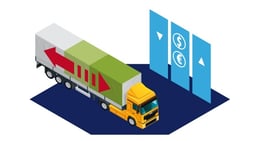5 More Logistics 4.0 Stats Worth Knowing
Jesse Kelber - August 06, 2019

 In our last look at Logistics 4.0 statistics, we discussed 5 that we feel will help define the shipping and logistics sector in the coming years. Today, we’re going to add to that list with 5 numbers we feel might be getting short shrift in coverage of this arena. Logistics is undergoing a collection of disruptions that seem to have hit out of the blue. There’s a seeming tsunami of dissatisfied customers, rising fuel costs, and global weather pattern changes, to name but a few. In order to respond appropriately, the shippers of the world have had to pivot, fast. Many are choosing to dive headfirst into the emerging world of Industry 4.0 technologies that promise to help predict at least some of these disruptions far enough in advance that alternative plans can be set in motion. Among the technologies seeing increasing adoption are AI, machine learning, RPA, and IoT. These technologies, combined with intelligent deployment tactics, are already having a big impact on the global supply chain.
In our last look at Logistics 4.0 statistics, we discussed 5 that we feel will help define the shipping and logistics sector in the coming years. Today, we’re going to add to that list with 5 numbers we feel might be getting short shrift in coverage of this arena. Logistics is undergoing a collection of disruptions that seem to have hit out of the blue. There’s a seeming tsunami of dissatisfied customers, rising fuel costs, and global weather pattern changes, to name but a few. In order to respond appropriately, the shippers of the world have had to pivot, fast. Many are choosing to dive headfirst into the emerging world of Industry 4.0 technologies that promise to help predict at least some of these disruptions far enough in advance that alternative plans can be set in motion. Among the technologies seeing increasing adoption are AI, machine learning, RPA, and IoT. These technologies, combined with intelligent deployment tactics, are already having a big impact on the global supply chain.
21%
The additive manufacturing industry grew by 21% in 2017 alone. That amounted to a value of $7.3 billion, according to the 2018 Wohler’s Report. By 2025, Wohler’s expects that number to explode to nearly $50 billion in revenue. Additive manufacturing is the industry way of saying 3D printing. What, we can hear you asking, does that have to do with shipping and logistics? Well, quite a lot actually. The decrease in lead times and increase in production capacity possible with additive manufacturing, coupled with the truly on-demand nature of this production method, means on-demand shipping is going to become a highly sought after commodity. Of the technologies listed above, IoT sensors and RFID tracking stand to have the greatest impact on the ability of logistics providers to keep up with these growing expectations. The combination of sensors and tags means smart trucks will be able to receive notifications when an order is approaching completion and where to pick the shipment up. Along with real-time weather conditions and estimated fuel costs, the smart trucks will have their routes all planned out before they even arrive to collect the order, further decreasing transit times.
Source: http://wohlersassociates.com/2018report.htm
75%
Organizations say they WANT visibility into events affecting their inbound supplies at a rate of 75%. Yet, only 29% say they actually have the degree of transparency they need to make accurate forecasting decisions. As Industry 4.0 spreads through the manufacturing world, these companies are starting to realize that the biggest bottleneck in their supply chain is the irregular nature of their supply deliveries. Not knowing precisely when an order will arrive often means equipment sits idle, delaying production and causing a cascade of further delays all the way up and down the value chain. Logistics companies will have to find ways to up their game if they want to match the digital transformation of their manufacturing partners. By adopting related technologies, shippers and planners can enable their customers to see each and every detail they need to more accurately plan production runs and deliveries to keep the chain running smoothly.
Source: https://www.zetes.com/en/news/infographic-industry-40-key-hurdles-and-how-to-overcome-them
68%
Decision makers in manufacturing lack access to the data they need to make the best decisions for the company. 68% of them, according to a recent survey by Zetes. Add to that the fact that 21% of these same decision makers are using fax machines to share information, and you can see how much room there is for improvement. When factors that affect the company's bottom line and ROI are at stake and key decisions are made based on scribbled notes being sent back and forth via fax, there are bound to be problems. Manufacturing is increasingly going digital, and logistics will need to play catch up if shippers and freight forwarders can hope to continue serving their customers at the levels they’ve come to expect. When the answer to “how do you know that?” is, “my gut,” it’s time to ditch the fax.
Source: https://www.zetes.com/en/news/infographic-industry-40-key-hurdles-and-how-to-overcome-them
53%
There’s one segment of a product's journey from a pile of raw materials to the customer's door that eats up the majority of shipping costs annually—53% of the costs, to be precise. That segment is the last mile, and the problem with last-mile is fundamentally one of efficiency. With the meteoric rise of ecommerce in recent years, two glaring issues have come to light for the logistics sector: customer expectations and a massive increase in the sheer volume of parcels being shipped. Customer expectations are now such that they expect inexpensive, or even completely free, shipping. Not only that, but they want their items NOW, with next day shipping the fastest growing option from many ecommerce sites. This often leaves the retailers and their logistics partners footing the bill. On-demand shipping, autonomous delivery vehicles, and precise inventory controls are going to be the keys to cutting these costs going forward.
The sheer volume of packages being shipped is staggering. It’s simple math: more people shopping online means more items needing to be delivered. And the current, outdated shipping and logistics infrastructure just can’t keep up. If you’re still using pen and paper to track your shipping schedule you’re going to be left in the dust. The technologies that stand to have the greatest impact on last-mile shipping costs are drones, autonomous delivery vehicles, crowdsourcing, and of course IoT sensors and RFID tracking on the packages themselves. It’s these areas where we’re seeing a growing number of startup activity, not to mention the existing big players investing heavily in research into these options, and more.
Source: https://www.businessinsider.com/last-mile-delivery-shipping-explained
32/100
McKinsey scores organizations on their overall state of digitization, and for the European logistics industry that score is 32. On a scale of 100, these companies scored a collective 32. That’s compared to a score of 62 for the “digital leaders” across the continent. Digital transformation can’t come soon enough to the logistics industry, as those leading companies are exactly who shippers are going to be going up against as they spread into the logistics industry, looking to force progress in what many see as a stagnant sector. Companies like Amazon and even Google are working on ways to disrupt logistics with technology. This is the time for existing logistics organizations to step up and show that they see the future possibilities in technological advances and are ready to embrace them.
LATEST POSTS
- Understand Why Production Planning Needs Specialized Solutions
- Understand Circular Economy in The Manufacturing Industry
- How Can Industry 4.0 IT Integration Be Achieved Smoothly?
- The Significance of Order Sequencing in Discrete Manufacturing
- How to improve your Supply Chain Management: The Power of Control Towers



